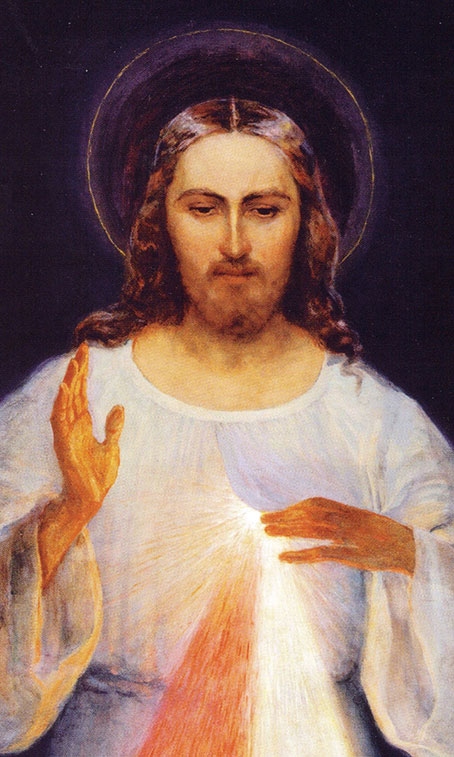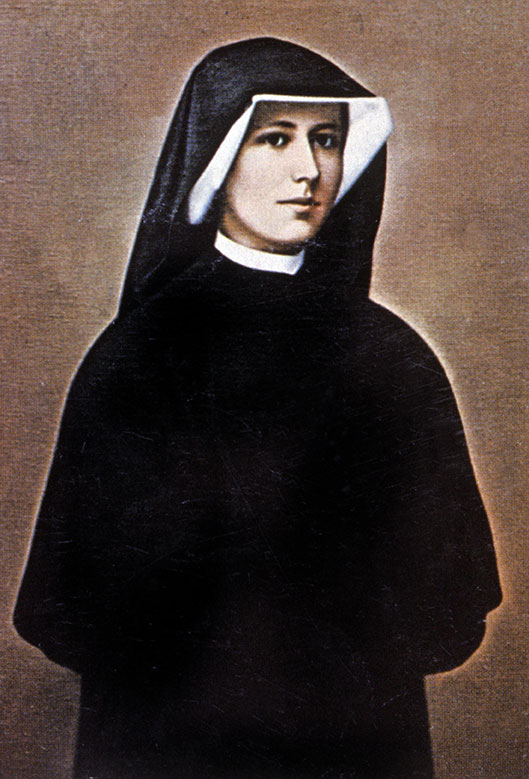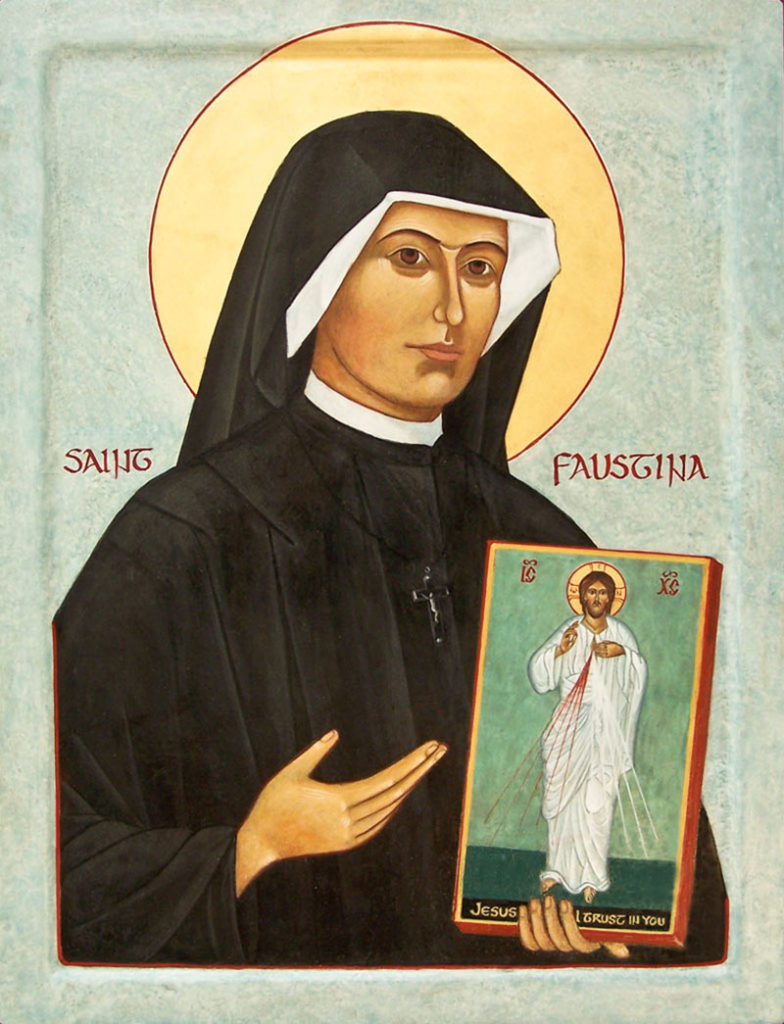In Sister Faustina Kowalska (1905-1938), the holy apostle of Divine Mercy, seer - and above all hearer - of the Merciful Christ, reveals to us the infinite treasures of God's Love. It is logical for the reader to wonder about her: who was she? what is her biography? what does her life story tell us? what does she tell us? Diary? Perhaps it is good to situate the figure of this saint within her mission. Faustina Kowalska, a simple woman from the great Polish countryside, belonging to the Congregation of the Sisters of the Mother of God of Mercy, was chosen to announce Divine Mercy in a renewed way.
Biography of Saint Faustina
Sister Maria Faustina was the third daughter of a poor and large peasant family from Głogowiec, a village near the city of Łódź. She was born in 1905 and her name was Helena.
It was a hot Sunday in June 1924. It was dusk in Łódź. Her sisters Gieni and Natalia invited her to a party. Helena was not very eager, but they bought her a ticket. A young man asked her to dance. She tried to evade by saying she didn't know, but at his insistence, she gave in. In the middle of the dance she froze, apologized and left the party with the excuse of a sudden headache. Later he would write in his Diary: "As the dance began, I suddenly saw Jesus on the side. He appeared as if on the Way of the Cross, in pain, without clothes, full of wounds. And as if He were a jealous young man, He asked me in pain: 'How long will I have to keep suffering for you, how long will you keep deceiving me?'".


At that moment everything in his life changed. The encounter with Christ marked him with a sign that lasted forever. It was something sudden, unexpected, and overwhelming. From that moment on "only Jesus and I are left".as he would later note in his Diary. When she left the party, she immediately went to the nearest church, St. Stanislaus of Kostka. There he asked for forgiveness, remained in silent prayer asking what he should do and listened for the second time to the voice of the Lord within him: "Go immediately to Warsaw; there you will enter a convent.". At the age of eighteen, and without her parents' permission, she arrived in Warsaw, a city totally unknown to her, and sought a convent. The superior of the Daughters of Divine Mercy was convinced of her vocation and accepted her as a postulant. Maria Faustina entered as a postulant in 1925 and during her thirteen years as a religious she lived in different convents and cities. In Krakow (Łagiewniki) she spent most of her time as a postulant and her last two years of life. In Warsaw he began his journey. In Płock, on February 22, 1931, Jesus spoke to her for the first time while she was already a nun.
In the Diary Fautina, several constants can be appreciated. In the first place, the apparitions of Jesus, which are marked in a concrete time and place that indicate the objective veracity of a personal apparition. Then it is striking that the Merciful Jesus always appears to communicate something. Another constant is the presence of the spiritual director. At the beginning it was Father Józef Andrasz SJ.
With the apparitions of Jesus came to Sr. Faustina the question of whether she should create a new congregation dedicated to imploring mercy for the world. In Łagiewniki she meditated on it, but she would not do anything without the approval of her spiritual director, who was Father Józef Andrasz. The latter advises him to remain in the order and from there to proclaim the message of Divine Mercy.
Sister Faustina took with great joy the continuous changes of house. In Vilnius she had a lot of work and many difficulties, but that was not what worried her. The most important thing that happened to her had to do with her spiritual life. Faustina finally found the priest for whom she had prayed so much: a spiritual director who also served as a support for her in putting the Lord's will into action. This confessor was Michał Sopoćko, now Blessed. When she recognized in Father Sopoćko the priest she had previously seen with the eyes of her soul, she once again heard within herself the words of Jesus: "This is my faithful servant, he will help you to fulfill my Will here on earth.". In 1934 Faustina fell ill with tuberculosis and, at the express request of her spiritual director, she began to write her Diary. In 1936 he moved again to Krakow and there he lived, suffered and died, in 1938, in a simple and holy way.


Divine Mercy Message
The message proclaimed by the saint brings with it new forms of worship that are born of God's express will. We can list five forms.
1) The image with the inscription "Jesus, in You I trust" is the figure of the Merciful Jesus, one of the most famous depictions of the crucified and risen Christ in the history of the Church and the world. He was in his room, in the convent of Płock, when he received the commission to paint the picture. It was February 22, 1931.
Narrates in his Diary: "In the evening, while I was in my cell, I saw the Lord Jesus dressed in a white robe. He had one hand raised in blessing, and with the other He was touching the robe on His breast. From the opening of the tunic on his chest, two large rays were coming out: one red and the other pale. After a moment, Jesus said to me: Paint an image according to the model you see, and sign: Jesus, I trust in You. I wish this image to be venerated first in your chapel and then in the whole world.".
Two years passed since the assignment in Płock and Faustina did not succeed in carrying out the mission. Having completed her perpetual vows, in 1933 she was sent to Vilnius. There, Father Michał Sopocko introduces her to the artist Kazimierowski, who, with Faustina's precise indications, paints the picture. Once finished, in spite of the artistic and religious value of the work, which is now in the sanctuary of the Divine Mercy in Vilnius, Faustina was not satisfied and wrote in her Diary: "I went to the chapel and cried a lot. I said to the Lord: Who can paint your beauty? And then I heard these words: The greatness of this image is not in the beauty of colors and canvases, but in my grace.".
A few years after Faustina's death, in 1943, on the instructions of Father Józef Andrasz, the painter Hyla made a second model. This is the miraculous image in the chapel of the convent of the Sisters of the Mother of God of Mercy in the sanctuary of Divine Mercy in Krakow-Łagiewniki, occupies a special place in the iconography and the cult of Divine Mercy. It is an image of Christ highly venerated by the faithful, and famous for the numerous graces received, and whose copies and reproductions can be found everywhere on all five continents of the world.
2) The Feast of Divine Mercy on the second Sunday of Easter. In the Diary we can read what Jesus says to Sister Faustina: "I desire that the first Sunday after Easter be the Feast of Mercy. I desire that the Feast of Mercy be a refuge and shelter for all souls and especially for poor sinners. On that day the bowels of My mercy are open. I pour out a whole sea of graces upon the souls who approach the fountain of My mercy. The soul who goes to Confession and receives Holy Communion will obtain total forgiveness of sins and sorrows. On that day, all the divine floodgates through which graces flow are opened.".
Cardinal Francis Macharski was the first to include the Feast of Mercy in the liturgical calendar for his archdiocese of Krakow (1985). This was followed by a number of Polish bishops in their dioceses. At the request of the Polish episcopate, Pope John Paul II instituted this feast in 1995 in all the dioceses of Poland. On the day of Sister Faustina's canonization, April 30, 2000, the Pope instituted this feast for the whole Church.
3) Chaplet to the Divine Mercy. A common five decade rosary is used to pray this prayer. It begins with an Our Father, a Hail Mary, and a Creed. At the beginning of each decade on the large beads of the Our Father it is said: "Eternal Father, I offer You the Body, Blood, Soul and Divinity of Your Most Beloved Son, Our Lord Jesus Christ, for the forgiveness of our sins and those of the whole world.". In the small beads of the Ave Maria is repeated: "Through Your sorrowful Passion, have mercy on us and on the whole world.". At the end of the five tens of the crown, it is repeated three times: "Holy God, Holy Mighty One, Holy Immortal One, have mercy on us and on the whole world.".
In the Diary we find these words of the Lord addressed to Faustina: "Encourage people to say the Chaplet I have given you. Whoever recites it will receive great mercy at the hour of death. Priests will recommend it to sinners as their last refuge of salvation. Even if the most hardened sinner has recited this Chaplet at least once, he will receive the grace of My infinite Mercy. I desire to grant unimaginable graces to those who trust in My Mercy. Write that when they say this Chaplet in the presence of the dying, I will place Myself between My Father and the dying. él, not as a Just Judge but as a Merciful Savior"..
4) The hour of Mercy, at three o'clock in the afternoon. About this hour of Mercy, the Lord said to Sister Faustina: "At three o'clock, pray for My mercy, especially for sinners, and if only for a very brief moment, immerse yourself in My Passion, especially in My abandonment at the moment of My agony. This is the hour of great mercy for the whole world.". It is about keeping in mind the moment of Jesus' agony on the cross, that is, to accompany him praying at three o'clock in the afternoon.
There is no specific prayer proposed for this hour, you can pray the Way of the CrossIf time does not permit due to obligations, at least, for a few moments, wherever we are, try to unite ourselves with Him as He agonizes on the Cross. The Chaplet can be one of the ways to live the Hour of Mercy, making a distinction since the Chaplet is addressed directly to God the Father, and the prayer in the Hour of Mercy to Jesus.
5) The propagation of the devotion to the Divine Mercy. "To the souls who spread devotion to My mercy, I protect them throughout their lives as a loving mother does her newborn child and at the hour of death I will not be for them Judge but merciful Savior."This promise, recorded in the Diary of St. Faustina, was made by Jesus to all those who proclaim Mercy in any way. To priests, the Lord made an additional promise: "Tell My priests that the most hardened sinners will soften under their words when they speak of My unfathomable mercy, of the compassion I have for them in My Heart. To the priests who proclaim and praise My mercy, I will give prodigious strength and anoint their words and shake the hearts to whom they speak.".
Krakow












